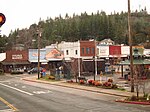Chicago Park, California
Unincorporated communities in CaliforniaUnincorporated communities in Nevada County, CaliforniaUse mdy dates from July 2023
Chicago Park (formerly: Storms Station) is a residential and unincorporated historic agricultural community in Nevada County, California. It is located along Highway 174, with its center at the intersection of Mt. Olive Road. The neighborhood gets its name from its founding residents, who came from Chicago to California in the late 1800s to grow fruit, which was often shipped back to Illinois for consumption. Chicago Park is about 9 miles southeast of Grass Valley and about 3 miles north of Colfax.
Excerpt from the Wikipedia article Chicago Park, California (License: CC BY-SA 3.0, Authors).Chicago Park, California
Lower Colfax Road,
Geographical coordinates (GPS) Address Nearby Places Show on map
Geographical coordinates (GPS)
| Latitude | Longitude |
|---|---|
| N 39.145277777778 ° | E -120.96722222222 ° |
Address
Lower Colfax Road 17798
95945
California, United States
Open on Google Maps




